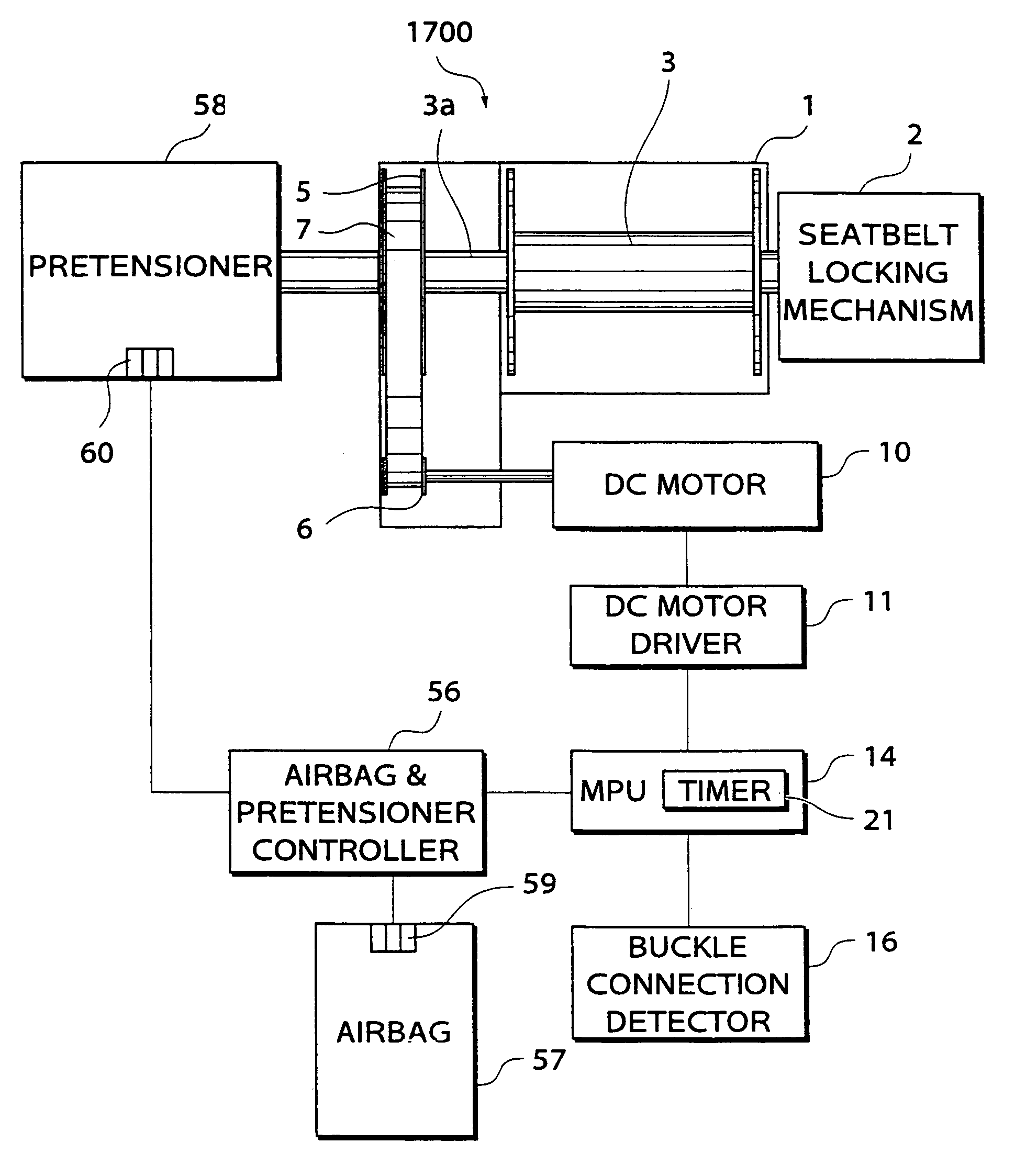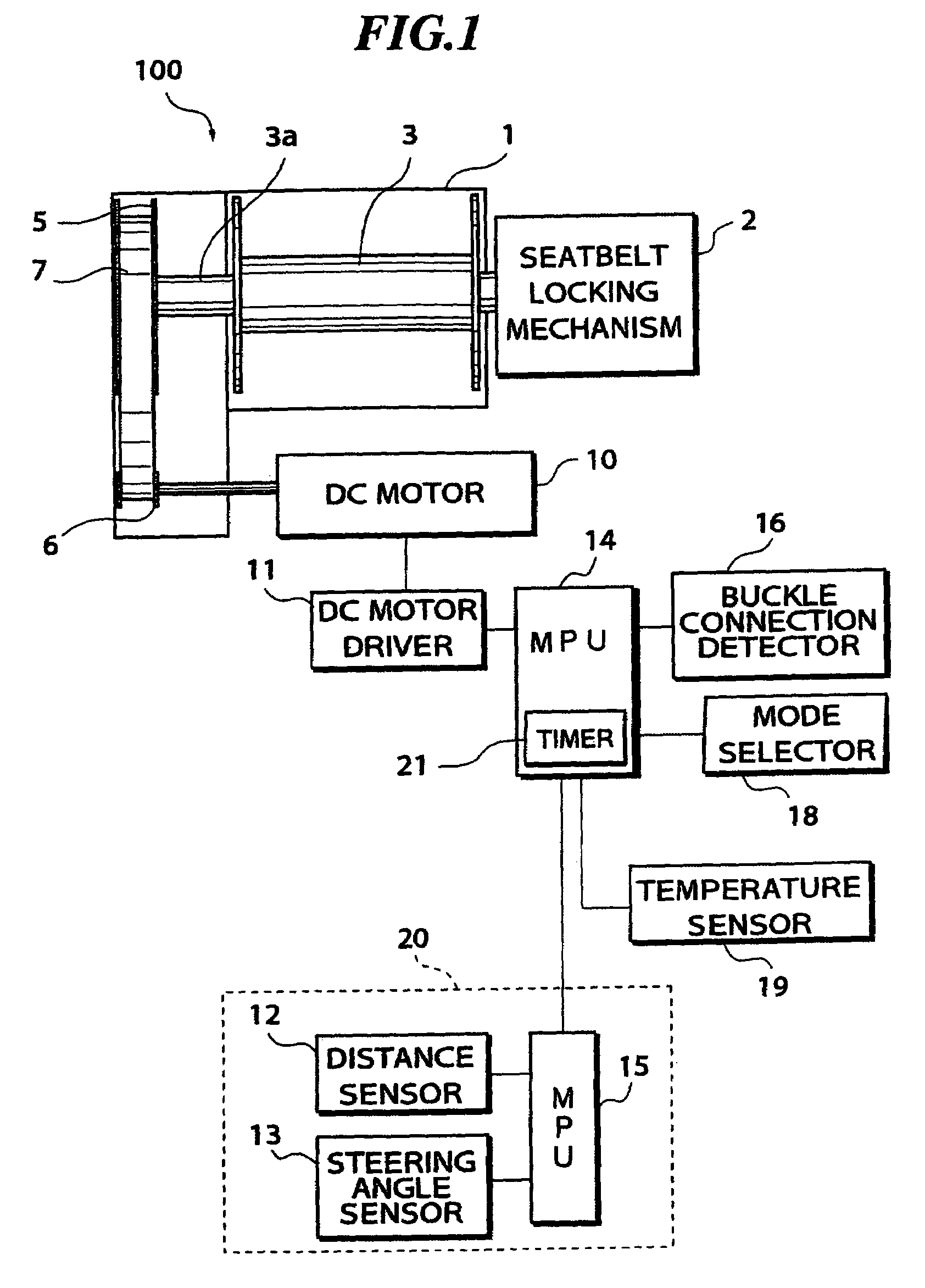Automotive passenger restraint and protection apparatus and seatbelt protraction and retraction amount-detecting device
a technology for passenger seats and protection devices, which is applied in the direction of vehicle safety belts, pedestrian/occupant safety arrangements, vehicle components, etc., can solve the problems of occupants who have degraded physical ability, takes a long time to mount the seatbelt onto their bodies, and occupants feel uneasy, etc., to achieve a comfortable seatbelt attaching environment
- Summary
- Abstract
- Description
- Claims
- Application Information
AI Technical Summary
Benefits of technology
Problems solved by technology
Method used
Image
Examples
tenth embodiment
[0476]The tenth embodiment is distinguished from the eighth embodiment described above mainly in the contents of the seatbelt attaching control executed by the MPU 14 in attaching the seatbelt to the occupant.
[0477]The present embodiment includes an electric retractor which is identical in construction with the electric retractor 100 of the first embodiment.
[0478]FIG. 44 is a flowchart showing the seatbelt attaching control executed by the MPU 14 according to the present embodiment.
[0479]First, it is determined at a step S4901 whether attaching of the seatbelt tongue to the buckle has been detected by the buckle connection detector 16. If attaching of the seatbelt has not been detected, the present processing is immediately terminated, whereas if it has been detected, a control signal commanding to rotate the reel shaft 3 in the seatbelt retracting direction at a predetermined rotational speed is delivered from the MPU 14 to the DC motor driver 11 at a step S4902. Thus, the seatbelt...
eleventh embodiment
[0489]The eleventh embodiment is distinguished from the ninth embodiment described above mainly in the contents of the seatbelt attaching control executed by the MPU 14 in attaching the seatbelt to the occupant.
[0490]The present embodiment includes an electric retractor which is identical in construction with the electric retractor of the ninth embodiment.
[0491]FIG. 46 is a flowchart showing the seatbelt attaching control executed by the MPU 14 according to the present embodiment.
[0492]First, it is determined at a step S5101 whether attaching of the seatbelt tongue to the buckle has been detected by the buckle connection detector 16. If attaching of the seatbelt has not been detected, the present processing is immediately terminated, whereas if attaching of the seatbelt has been detected, a control signal is delivered to the DC motor driver 47 to rotate the reel shaft 3 in the seatbelt retracting direction at a predetermined rotational speed at a step S5102. Thus, the seatbelt is re...
twelfth embodiment
[0501]The twelfth embodiment is characterized by seatbelt storing control executed by the MPU 14.
[0502]The present embodiment includes an electric retractor which is identical in construction with the electric retractor of the eighth embodiment.
[0503]FIG. 48 is a timing chart showing the relationship between the driving force of the reel shaft 3 for retracting the seatbelt and the seatbelt retracting speed of the reel shaft 3.
[0504]In the present embodiment, as shown in FIG. 48, when release of the seatbelt is detected, retraction of the seatbelt is started with a constant magnitude of driving force by the reel shaft 3. The MPU 14 determines whether the retraction of the seatbelt is just about to be terminated (time point n), based upon the terminal voltage across the DC motor 10.
[0505]If the retraction of the seatbelt is just about to be terminated (time point n), a control signal is delivered to the DC motor driver 11 to decrease the rotational speed of the reel shaft 3 in the sea...
PUM
 Login to View More
Login to View More Abstract
Description
Claims
Application Information
 Login to View More
Login to View More - R&D
- Intellectual Property
- Life Sciences
- Materials
- Tech Scout
- Unparalleled Data Quality
- Higher Quality Content
- 60% Fewer Hallucinations
Browse by: Latest US Patents, China's latest patents, Technical Efficacy Thesaurus, Application Domain, Technology Topic, Popular Technical Reports.
© 2025 PatSnap. All rights reserved.Legal|Privacy policy|Modern Slavery Act Transparency Statement|Sitemap|About US| Contact US: help@patsnap.com



